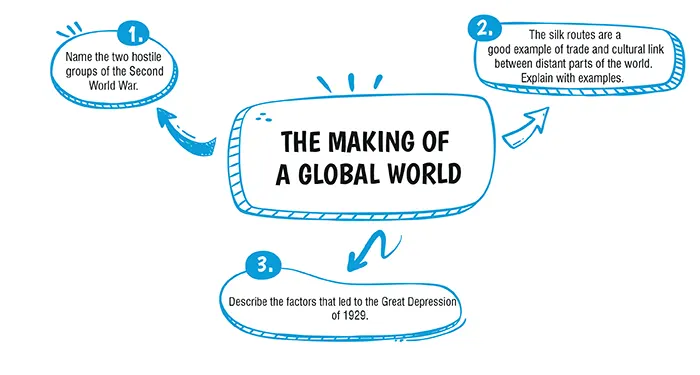Home / Boards / CBSE / Important Questions / Class 10 / Social Science / The Making of a Global World
Table of Contents

Ans. (d)
Explanation:
Three important developments that greatly shrank the pre-modern world were the flow of trade,labour and of capital.
Ans. (a)
Explanation:
During the 19th century, many Europeans faced poverty and poor living conditions due to overpopulation, lack of employment opportunities, and agricultural failures.
Explanation:
During the Second World War , there were two hostile groups that engaged in combat with one another:
Explanation:
From Asia, Chinese silk and pottery and Indian spices and textile would be traded to Europe; while in return, the precious metals like Gold and Silver would come to Asia. Along with this trade, there was a cultural exchange as well, as Christian missionaries and Muslim preachers would also travel.
Download Mind Map of this chapter
Download NowWant to Practice Mock Tests of this chapter
Practice NowDownload Important Questions of this chapter
Download Now| Chapter No. | Chapter Name |
|---|---|
| History | |
| Chapter 1 | The Rise of Nationalism in Europe |
| Chapter 2 | Nationalism in India |
| Chapter 3 | The Making of a Global World |
| Chapter 4 | The Age of Industrialization |
| Chapter 5 | Print Culture and the Modern World |
| Geography | |
| Chapter 6 | Resources and Development |
| Chapter 7 | Forest and Wildlife Resources |
| Chapter 8 | Water Resources |
| Chapter 9 | Agriculture |
| Chapter 10 | Minerals and Energy Resources |
| Chapter 11 | Manufacturing Industries |
| Political Science | |
| Chapter 12 | Power – sharing |
| Chapter 13 | Federalism |
| Chapter 14 | Gender, Religion and Caste |
| Chapter 15 | Political Parties |
| Chapter 16 | Outcomes of Democracy |
| Economics | |
| Chapter 17 | Development |
| Chapter 18 | Sectors of the Indian Economy |
| Chapter 19 | Money and Credit |
| Chapter 20 | Globalization and The Indian Economy |
| Chapter Wise Important Questions for CBSE Board Class 10 History |
|---|
| The Rise of Nationalism in Europe |
| Nationalism in India |
| The Making of a Global World |
| The Age of Industrialization |
| Print Culture and the Modern World |
CBSE Important Questions Class 10
ICSE Important Questions Class 10
CBSE Important Questions Class 10
ICSE Important Questions Class 10